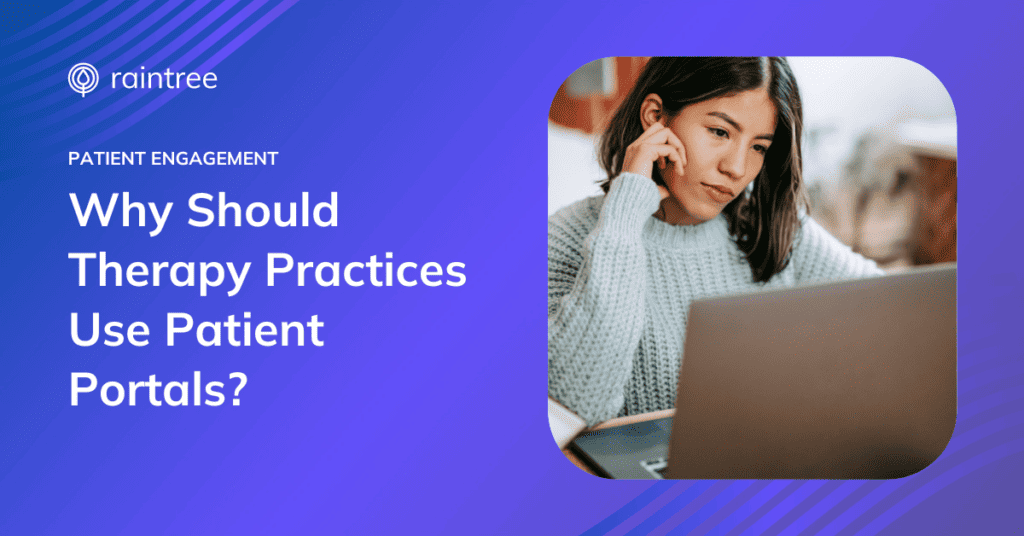
While we continue to see rapid advancement in digital healthcare experiences and self-service engagement, it’s a no-brainer that patient portals offer exceptional value to therapists and patients alike.
For rehabilitation therapists, portals can streamline digital intake and patient registration processes as well as reduce time spent on clinical, administrative, or billing tasks. At the same time, patients can benefit from the convenience of online access to medical records, visit summaries, and eStatements, along with other communication opportunities such as direct messaging or telehealth.
However, with more rehabilitation therapy practices adopting patient portals, it’s important for therapists and business owners to deepen your understanding of the value patient portals bring. In doing so, you’ll be able to better pinpoint any barriers to patient portal adoption and overcome these hurdles through collaborative care, engaging communication, and follow-up education.
What is a Patient Portal?
A patient portal is a HIPAA-compliant, online platform with a secure username and password, where patients can access their personal health information (PHI), visit notes, treatment plans, bills, and basically everything they may need throughout their entire healthcare journey, including current medications, immunizations, allergies, as well as lab results.
Many patient portals also include a myriad of self-service tools, such as appointment management features, virtual payment options, and a messaging center that allows for direct communication with your therapy practice. So with all of that in mind, why is it that only 40% of patients reported accessing their records at least once via a portal in 2020?
Well, a lot has changed since then! That’s why informing your patients of the benefits of using a patient portal is key to increasing adoption rates and boosting client retention with more positive feedback.
Why Should Therapy Practices Use Patient Portals?
Since electronic health records (EHR) debuted in 2009, therapy practices have been making the move to all things digital! And of the advancements that have sprung from this cloud-based movement, patient portals have paved the way for technology-enabled solutions that benefit both providers and patients.
What are the Benefits of Patient Portals for Providers?
As a therapist, having patients that actively engage with you online can positively impact your practice in more ways than one! By leveraging a patient portal, you can reap the benefits of personalized patient engagement, increased communication through virtual channels, as well as improved copay and billing collections through convenient online payment options.
Additionally, when you choose the right patient portal, you’ll help lessen your staff’s workload by streamlining routine tasks as well as automating workflows, engagement campaigns, and so much more. Plus, research shows that practices that offer patient portals with appointment reminders and the ability to reschedule visits as needed have seen a reduced number of visit cancellations or no-shows.
What are the Benefits of Patient Portals for Patients?
Beyond the improvements that any functional and utilized self-service software can offer your therapy practice, patient portals were ultimately created for patients. From easing accessibility to achieving greater engagement, patient portals empower patients with a full set of dynamic self-service features.
With a patient portal, your patients can conveniently request, cancel, or change appointments online instead of needing to contact your office, all of which simplifies scheduling and balances in-office visits – even check-ins can be streamlined through virtual pre-registration! What’s more, with eStatements and personal payment plans, a patient portal can truly serve as a one-stop shop for your therapy practice.
How to Increase Patient Portal Use
A major reason that self-service platforms are under-utilized is that providers simply aren’t informing patients about portals, despite having one available.
Why do patients not use patient portals?
A study published by the American Medical Association in 2019 found nearly 40% of patients surveyed were not being offered access to a portal at all! Patients cited several other reasons for choosing not to use patient portals:
• 57% reported they felt no need to use the portal
• 32% cited a lack of online medical record
• 25% reported no internet access, especially in rural areas
• 22% cited privacy concerns
So whether it’s privacy concerns or a patient’s personal preference for speaking face-to-face with their therapy provider, how can your practice adequately address the need for a patient portal? It’s simple: Encourage patients to use it!
The Power of Proactive Patient Education
Despite living in a world powered by technology, many patients are completely unaware that they can access their medical information online! Likewise, many are surprised to learn that they can speak directly to their therapy and rehab provider through a patient portal.
A 2018 study conducted by the University of Michigan reported that a staggering 95% of patients that accessed a patient portal did so under the recommendation of their provider! Furthermore, this same study identified trends that suggested a lack of internet access was not as high a priority issue as initially suspected, and instead, patients were opting out to avoid the discomfort of using the technology itself.
By educating patients on the ins and outs of patient portals as well as detailing the many benefits of its self-service functionality, the likelihood of increased adoption looks promising! And the 2020 Health Information National Trends Survey (HINTS) proves it, with:
- 22% of patient portal users accessing their information via a smartphone and computer
- 17% using a mobile app on their smartphone to access a patient portal
- 61% of portal users using a computer to view their healthcare information
- 60% exchanging secure messages with healthcare providers through the patient portal
- 50% using the patient portal to view clinical notes by their healthcare provider
- 90% of portal users viewing lab test results
Raintree Offers the Most Complete Patient Portal for Rehabilitation Therapy Practices
The preferences have been made clear: patients want to see accessible, mobile-friendly patient portals that offer a comprehensive overview of their personal health information as well as supply secure, private communication channels. Check out these 3 tactics for self-service patient engagement to get started!
From self-scheduling and automated messaging to virtual payment options and embedded telehealth, Raintree’s patient portal is the most powerful, flexible solution for therapy and rehab practices. Our all-in-one EMR is also seamlessly unified with Connect, so that you can leverage every patient engagement tool you’ll ever need to foster patient relationships. Schedule a free demo today!
